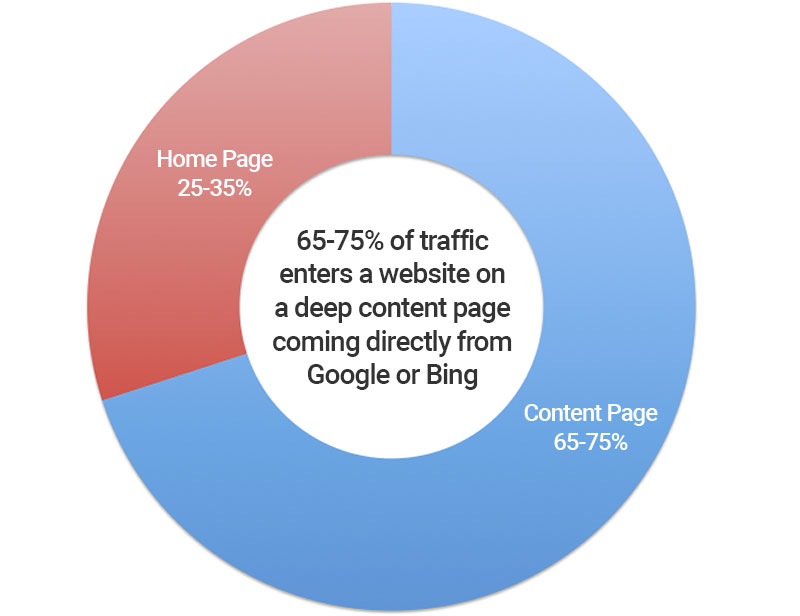New content
There was a lot of talk at this year's LMA Convention about personalization of legal marketing websites. The idea being that if you make a site more relevant to the person viewing it, they're more likely to engage with you. This is nothing new and in theory, we couldn't agree more. For many years we've been personalizing website experiences based on information such as IP address, screen size, language, browser version, etc. -- all non-personally identifiable information.
While I'm usually enthusiastic about advances in technology, some personalization and profiling techniques should be carefully considered because they can be expensive, time consuming and could potentially backfire.
One alternative to deep profiling is automated content discovery.
Key Concepts
- There are serious ethical and privacy concerns that arise with advanced personalization and profiling that should be carefully considered
- Content discovery is important because 65-75% of visitors bypass the home page and enter your site on deep content pages via a Google search
- Content discovery shows related/relevant items below main copy and invites a visitor to discover more content along the same topic (you've seen this on news sites, Buzzfeed and other savvy internet properties)
- With the right website platform, Content Discovery can be automated and have zero impact on internal resources
- We think focusing on Content Discovery is better, faster and WAY cheaper than focusing on website personalization
- End result is similar: providing a richer, more relevant experience for the visitor. The upfront and ongoing cost is substantially different.
Background
At a high level, there are three basic kinds of information that can be used for personalization:
Environmental
- This visitor's environment provides information that can be used to personalize the experience
- Examples: browser, browser version, browser language, operating system, IP address, referring website, referring search term, screen size, cookies
Explicit
- The visitor identifies themselves by logging in, filling out a form, or explicity allowing location services
- Content is tailored specifically to them as a known individual
- Often they will interact with the site, changing various criteria to suit their needs
- Examples: Facebook, YouTube, Amazon, Map applications, your banking website – on the more basic side, a newsletter signup form
Heuristic or Behavioral (sometimes called Implicit)
- The person does not identify themselves but is profiled through various criteria or behavior signals
- Content is tailored to suite those criteria/signals
- Common criteria: behavior within site such as pages viewed, content categories viewed, conditionals such as if an item has been added to a shopping cart, terms searched for, websites visited (remarketing campaigns, adwords, etc.)
Emerging technologies are generally an extension of implicit tracking and include:
- Customization via sophisticated tracking/profiling and development of a digital fingerprint (fingerprint canvassing) that triangulates various anonymous criteria allowing for the creation of a personally identifiable profile
- Direct tie into CRMs that track known and unknown users based on cookies/IP/digital fingerprint, etc.
- Machine learning where algorithms assess behavior over a large amount of data and provide predictive analysis that can be used to tailor features/content
There are many variations and permutations of this tracking information and how it can be used to create a digital profile of your behavior on the web. Some of the emerging technologies are not detectable and cannot be disabled.
Social media and shopping websites have been profiling users and adjusting content for years. Many use predictive analysis and machine learning to make small changes to their sites that have a huge impact on their bottom line. So none of this is new.
What is relatively new is that Law Firms and other professional services firms are starting to dip their toes in the personalization water beyond the basics and here's where it gets interesting -- and some might even say, troubling.
Pros and Cons
Cons

While someone might expect Amazon to track their behavior and show them similar books or shoes, I'm not sure most people expect their lawyer to do the same thing without explicit permission. Even if it's more convenient, the kind of tracking and profiling required to do deep personalization brings up ethical and privacy questions that should be fully considered. Professional ethics, privacy concerns and the expectation of confidentiality (deserved or not) need to be weighed against the benefits of tracking individuals online.
In theory deep personalization sounds great: Joe, our client from Company A just looked at the website. Let's call Joe to see how he's doing –or– let's show Joe the latest client alert from the practice that handles his matters on the home page. Awesome, we can communicate with Joe in a decision making process or give Joe more relevant information because we know it's him. With this information, we can potentially sell more of our legal services to Joe.
What marketer wouldn't want that scenario?!
But how does it really work? Who else in the firm knows that Joe is a client? Are there access restrictions to that information? Who outside the Firm has access to that information (e.g., various vendors)?
Law firms don't sell shoes. They sell trust. In our opinion, maintaining that trust MUST take precedence over advanced marketing techniques or there is nothing to actually sell.
Other cons to deep user profiling/personalization:
- Required resources (time and money, both internal and external)
- Building consensus about personalization rules
- Upkeep (editing multiple versions becomes impractical on a large site)
- Inconsistent views (user A's view is different than user B's view is different than user C's view -- by design. If you're a website editor and a lawyer is complaining about a page, which version are they actually seeing?)
- Unintended consequences (you don't know what you don't know)
Pros
Don't get me wrong; certain types of personalization are good, relatively inexpensive – and can be done anonymously.
Language
Browsers (IE, Chrome, Firefox, Safari) report the language preference of the visitor. If your site has been translated into the language being reported, the site should show that language by default without the visitor needing to manually switch languages.
Localization
IP information is also provided as part of every web page request. Many IP addresses are associated with specific locations. The website view can be customized for that location (e.g., displaying office information local to that visitor). Websites can also ask a visitor for their location explicitly, which you can use for localization – this is an opt in feature so customization is expected.
Mobile/Display/Device
Customization of the page view depending on what size screen or device you're visiting from is now relatively common (responsive design and/or dedicated mobile sites). This customization creates a better customer experience and does not personally identify the visitor. Mobile is still not ubiquitous even though Google now lowers page rank if you don't have a mobile friendly site.
Shifting User Behavior

In the horse and buggy era of the Internet (early 2000s) visitors often traversed a site by drilling into sections, then returning to the home page and drilling into another section, like this:
Home Page > Practices Landing > Practice Detail Page
Back to Home Page > Attorney Landing > Page Attorney Bio
Back to Home Page > News Landing Page > News Article
Then search engines got more sophisticated, content management systems got more sophisticated and relational content started to become more prevalent (but surprisingly is still not ubiquitous). That gave us paths through the site that look something like this
Google > Article > Related Bio > Related Article > Related Practice > Related Bio
Notice anything missing?
Yep, the home page.
We work with many law firms, both large and small. Aggregate statistics show only 25-35% of traffic enters the site through the home page, depending on the site. This means 65-75% of traffic enters a website on a content page directly from Google or Bing.
Do not pass Go. Do not collect $200.
All the high value content featured and stressed about on your meticulously crafted home page banners that took 13 meetings to get approved will never be seen the majority of visitors. The home page is becoming less and less relevant but continues to be where the majority of high value content is featured.
Moving Beyond the Home Page and Finding an Alternative to Deep User Profiling at the Same Time
Q: If visitors are bypassing the home page and entering the site on destination content pages how can we keep them on the site, demonstrate expertise and present high-value relevant content in a frictionless way?
Q: If personalization based on deep user profiling can be problematic, what's a better, cheaper and less invasive way to provide relevant content to your visitors on a site-wide basis?
A: Automated Discoverable Content
To address both the shift in user behavior and as an alternative to deep user profiling, we've begun showing snippets of related content at the bottom of content pages with links to the full article.
As you get to the end of an article, there are 3-9 more to choose from without going anywhere else and without having to make much of a decision. The user is much more likely to click on a link that leads directly to more content, especially if that content is relevant to the current article.
This technique is common on sites like Buzzfeed, CNN, Huffington Post, and other savvy Internet properties. It's not common on legal sites. In fact, we pioneered it on KayeScholer.com

Discoverable content allows for paths through the site like this:
Google > Article > Article > Article > Bio > Article > Practice > Bio
By making relevant content more accessible the visitor gets to discover expertise within a practice or industry with less effort and frustration. Many sites have good content that is buried. Bringing that content to the surface serves not only to help the visitor, but it also helps search engines understand how the content on your site interrelates, which in turn helps with organic indexing your site properly as well (what you link to internally has impact on what Google understands about your site).
The secret sauce is automation.
The right website platform can make the process of creating discoverable content into something that has zero additional impact on your marketing staff. Even if your platform doesn't support automation, manually linking to 3-5 item on your site that may be of interest can help. Think along the lines of: same practice, same industry, same topic, same news thread, same or similar keywords.
We think focusing on content discovery is better, faster and WAY cheaper than focusing on website personalization
Better: content discovery allows your visitor to see more content that might interest them without you invading their privacy or getting creepy in any way.
Faster: you can start this today. Though it's easier with a powerful CMS, you can start doing this today on new articles that are put into the site and gradually go back in time to hit high ranking historical articles.
Cheaper: If you do have a capable CMS, this can be 100% automated and have zero impact on your marketing team's time. Enter an article and the related discoverable content is automatically available along the various lines of thinking mentioned above. And since the discovery relationship is an algorithm, it can be tweaked as new technology comes out. Also as new content is added that new content may become new relevant content for older, more established articles that people link to already. Content discovery is a self-fulfilling prophecy. Link it and they will read.
More importantly, it's close to frictionless to enable. Generally no committees need to be involved, there is no danger of violating ethical standards or evolving privacy laws, your client or potential client is provided with a more relevant and rich experience, which is a win for you and a win for them.
That sure seems a whole lot less creepy than fingerprint canvassing!
If you have any comments, questions or just want to say hi, please email me at todd.rengel@animusrex.com.